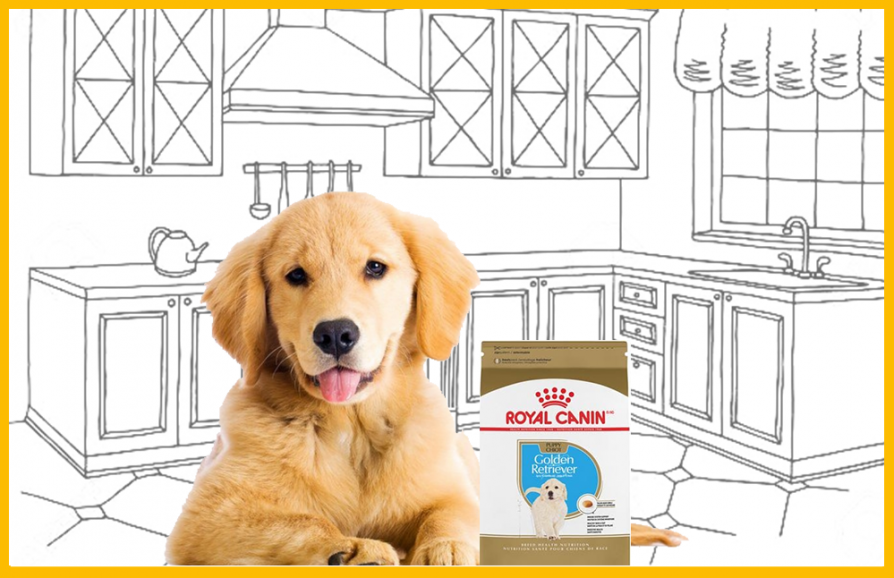Golden Retriever: Feeding patterns to know
- September 30th 2019

There’s no denying that a Golden Retriever is one of the most beautiful dogs there is. With a soft and luscious golden coat, large melting brown eyes and a playful and kind disposition to match, Golden Retrievers usually steal your heart and keep it.
If you’re thinking of bring a Golden Retriever puppy home, here is what you need to know about their feeding patterns and dog food.
Knowing your dog’s feeding patterns
Most pet parents can feel overwhelmed by what to feed their puppy. The options on the market are vast and it’s difficult to know what portion sizes are perfect for your dog. In the section below, we break down how much dog food may be perfect for your puppy as they are growing, but here are some general thoughts to keep in mind when thinking about feeding patterns:
Age: Always feed your dog according to
their age. Puppies may need to be more frequently fed than adult dogs, while
adult dogs may need more food in terms of quantity. There is also special dog food for
puppies to cater to their development.
Exercise: Remember that the cup portions given below are general, and feeding will differ from puppy to puppy. It all depends on how much exercise your dog gets and how energetic they seem.
Golden Retriever dog food by age
Two months old: When your Golden Retriever is two months old, they’re full of energy. They’re puppies at this stage and growing, so they need all the nutrients they can get. Vets usually recommend three meals a day for a two-month old pup, with half a cup of dry food per meal. That’s a total of one and a half cups per day for your puppy.
Three months old: Your puppy is growing bigger but they’re still puppies, so they need those calories. Increase portion sizes for dog food to around two and half cups per day. Ensure you don’t serve this all at once; divide those cups by three meals per day.
Four months old: You may need to increase the daily portion size to three cups per day, depending on how much your Golden Retriever is eating. Remember, always check your pup’s activity levels and ensure they’re getting enough exercise. If you’re ever confused about how well your dog is taking to these portion sizes, check with your vet.
Six months old and beyond: At this point, your Golden Retriever is nearly fully grown. Portion sizes may be increased to three and a half cups or four cups per day, but you don’t have to feed them as often. If your dog takes to it, you can reduce their meal times to twice a day.
It can help to stick to a schedule when feeding a Golden Retriever. Also remember that some dogs inhale their dog food like they’ve been starved all their lives. This doesn’t mean they’re actually being starved – some pets just like food. Don’t just increase portion sizes in a panic. Always keep an eye on your pet’s weight and ensure the diet works with their level of energy and exercise.
What is the best dog food for a Golden Retriever?
While you may know how much dog food to give your Golden Retriever, it can be difficult to know what food is best for them. The market is so flooded with dog food brand names, it can be hard to tell which ones to trust. Here are some of the more lauded brands:
Royal Canin: Royal Canin is so dedicated to providing Golden Retrievers with the perfect balance of nutrients that they’ve developed kibble specially for this dog breed: the Golden Retriever Puppy Dry Dog Food . This dog food by Royal Canin is specially designed for your Retriever’s scissor bite to improve chewing, and has extra nutrients to protect your puppy’s immune system as they grow. It also protects the skin to encourage a luscious coat.
Orijen Puppy Food: Rich in protein and fats from a variety of fresh whole meats,
Orijen Puppy Food is perfect for that energetic and growing pup. This puppy
food is extremely nutrient dense, with a rich 38% protein and a low 17%
low-glycaemic carbohydrates, making this high-quality kibble for a developing
canine.
Keeping your dog’s weight in check
While it’s important to feed your puppy, make sure you don’t feed them too much. It’s best to weigh your puppy to ensure they’re within healthy limits. An easy way to check your dog’s weight without the weighing scale is to feel under their fur. You should be able to feel your dog’s ribs without a thick layer of fat. Your dog’s shape is also a good indication of their level of fitness: their chest should be wider than their abdomen and there should be a noticeable tuck around the stomach.
Comments
No posts found
